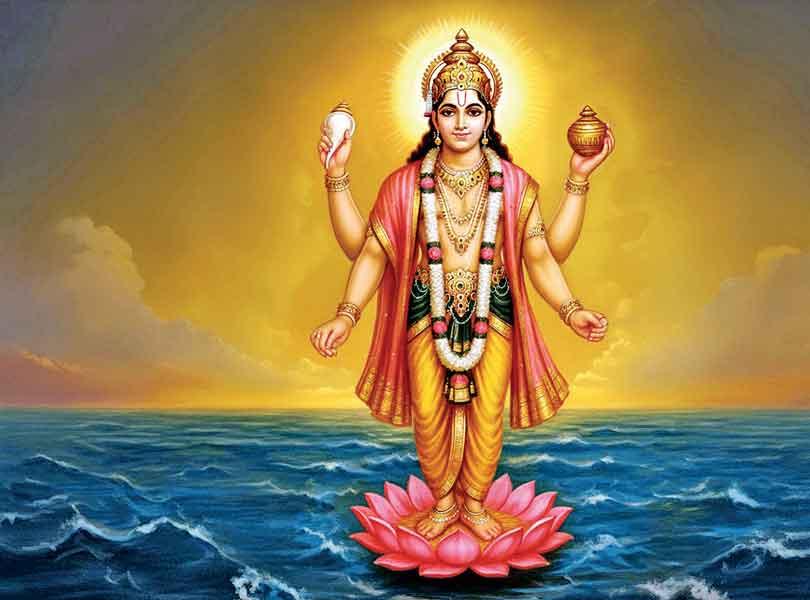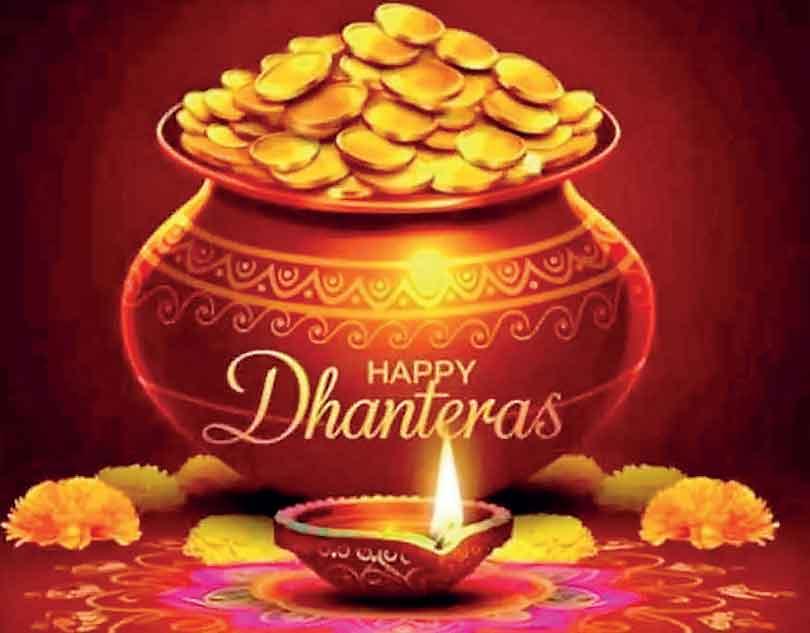

Dhanteras, also known as Dhanatrayodashi, marks the beginning of the five-day festival of Diwali, one of the most significant and widely celebrated events in the Hindu calendar. Observed on the thirteenth day (Trayodashi Tithi) of the Krishna Paksha (waning phase of the moon) in the month of Kartik, Dhanteras sets the tone for the festivities that follow. It is a day steeped in mythology, symbolism, and ritual, celebrating both material prosperity and spiritual well-being.
The Meaning Behind the Name
The word Dhanteras is derived from two Sanskrit roots: Dhan, meaning wealth, and Teras, meaning the thirteenth day. It is thus literally the “thirteenth day of wealth.” The day carries profound significance for Hindus, not only as a harbinger of good fortune but also as a reminder of the deeper meaning of abundance; that wealth, in its truest sense, includes health, happiness, and spiritual contentment.
The Mythological Origins
Several legends surround the origin of Dhanteras, each offering unique insights into why the day is celebrated with such reverence.
The Legend of Dhanvantari
One of the most popular myths relates to Lord Dhanvantari, the divine physician and the god of Ayurveda. According to Hindu mythology, during the great churning of the ocean (Samudra Manthan), numerous celestial treasures emerged from the depths of the sea. On the thirteenth day, Dhanvantari appeared holding a pot of amrita (nectar of immortality) and the sacred texts of Ayurveda, symbolising the healing of the body and the preservation of life. Hence, Dhanteras is also regarded as Dhanvantari Jayanti and celebrated as a day dedicated to health and well-being.
The Story of King Hima’s Son
Another beloved tale narrates that a young prince, son of King Hima, was fated to die on the fourth day of his marriage due to a snake bite, as foretold by his horoscope. However, his clever wife resolved to save him. On the appointed night, she lit numerous lamps, spread her ornaments and gold coins in a heap near the doorway, and told her husband to stay awake with her by singing songs and telling stories. When Yama, the god of death, arrived disguised as a serpent, he was blinded by the brilliance of the lights and mesmerised by the glittering gold. Unable to enter, he waited outside listening to the music, and by dawn, he quietly left. Thus, the prince’s life was spared. This story underscores the belief that lighting lamps and buying precious metals on Dhanteras can ward off negative forces and bring longevity.
The Spiritual Significance
While Dhanteras is often associated with material wealth, its essence goes far deeper. In the spiritual sense, the “wealth” that devotees seek is not merely gold or silver, but the illumination of the soul. Lighting lamps on this day symbolises the triumph of light over darkness, wisdom over ignorance, and good over evil. The ritual of cleaning homes, polishing utensils, and decorating entrances with rangoli and oil lamps is a physical manifestation of this inner cleansing, a symbolic gesture to purify the mind and prepare for divine blessings. Dhanteras thus becomes not only a day of economic prosperity but also a spiritual renewal, an invitation for divine energy to enter one’s home and heart.
Rituals and Observances
Dhanteras customs vary across regions in India, yet the underlying themes remain the same; reverence for wealth, health, and divine protection.
Buying Precious Metals and Utensils
It is customary on Dhanteras to purchase gold, silver, or new utensils. This tradition stems from the belief that buying something valuable on this day brings prosperity and good luck for the year ahead. In modern times, people may also invest in property, vehicles, or even electronic appliances, symbolically invoking abundance. Even a small token purchase, such as a silver coin or a brass lamp, is considered auspicious.
Worship of Dhanvantari and Goddess Lakshmi
Many devotees perform special pujas in the evening, invoking the blessings of both Lord Dhanvantari and Goddess Lakshmi, the goddess of wealth and fortune. Offerings of sweets, flowers, and lamps are made, accompanied by the chanting of sacred hymns such as the Dhanvantari Mantra and Lakshmi Aarti. In some households, sixteen small clay lamps (diyas) are lit and placed around the house, one for each direction, symbolising protection and prosperity.
Lighting the First Diya of Diwali
Dhanteras marks the first night of the Diwali festival, and so, the first lamp (diya) of the season is lit on this evening. The glow of these lamps is believed to guide Goddess Lakshmi into homes and drive away any inauspicious energies. Families often gather together to light lamps, share sweets, and exchange gifts, marking the start of the joyous Diwali festivities.
Regional Variations
India’s diversity ensures that Dhanteras is observed differently across states, each infusing the celebration with its own cultural flavour.
- In North India, the day is largely associated with purchasing gold, silver, and new utensils, while business communities worship their ledgers and account books as part of the Chopda Pujan, seeking blessings for success in the coming financial year.
- In Maharashtra, Dhanteras coincides with Yama Deepam, when small lamps are placed outside the home to appease Yama and pray for protection against untimely death.
- In Gujarat, Dhanteras marks the start of the new financial year, and businessmen open new account books, performing rituals for prosperity in trade.
- In South India, particularly Tamil Nadu and Kerala, the day is often observed as Dhanvantari Puja, focusing on health and healing rather than material wealth, in honour of the divine physician.
The Symbolism of Light and Wealth
The illumination of homes and temples on Dhanteras is more than a decorative act. In Hindu philosophy, light is synonymous with knowledge and self-realisation. The diya, a simple clay lamp, becomes a powerful metaphor: its flame burns upward, symbolising the soul’s aspiration toward higher consciousness, while its steady glow dispels darkness and fear. Similarly, the emphasis on wealth in Hindu tradition is not a celebration of greed but an acknowledgment of life’s balance. In the Artha stage of life, wealth (artha) is considered one of the four purusharthas, the legitimate goals of human existence, alongside dharma (righteousness), kama (desire), and moksha (liberation). Dhanteras, therefore, teaches that material prosperity, when pursued ethically and used wisely, can support spiritual growth and societal good.
Modern Interpretations
In the modern world, Dhanteras has evolved from a day of traditional rituals to one that also reflects contemporary aspirations. With the rise of digital transactions and e-commerce, many people now invest in gold digitally or make charitable donations instead of physical purchases. Corporate offices often distribute gifts or bonuses to employees, and the retail sector witnesses one of its busiest shopping days of the year. Yet, amidst the commercial bustle, the festival’s deeper message endures; gratitude for what one has, and faith in what the future holds. Many families also take this opportunity to donate to the needy, embodying the spirit of seva (selfless service), which is an integral part of Hindu ethics.
Dhanteras and the Broader Diwali Narrative
Dhanteras sets the spiritual and emotional stage for Diwali. The days that follow, Naraka Chaturdashi, Lakshmi Puja, Govardhan Puja, and Bhai Dooj, each carry their own meaning, collectively celebrating light, kinship, devotion, and renewal. In this sense, Dhanteras represents the seed from which the festival’s broader symbolism grows: the belief that light, wealth, and knowledge, when cultivated with integrity, bring harmony to both home and heart. The lamps lit on Dhanteras are thus more than ornaments; they are offerings to life itself; an acknowledgment of its abundance, fragility, and beauty.
Dhanteras, in essence, is a celebration of prosperity in all its dimensions, physical, emotional, and spiritual. It reminds us that true wealth lies not only in gold or possessions but also in health, knowledge, compassion, and the light we bring into others’ lives. As families across the world clean their homes, light their lamps, and make their offerings, they participate in an ancient rhythm, one that continues to unite generations through faith, gratitude, and the timeless quest for light amidst darkness.
In honouring both Dhanvantari and Lakshmi, Hindus affirm a profound truth; that life’s greatest riches are those that sustain and uplift, heal and enlighten. And so, with every lamp lit on Dhanteras, a small victory of light is won, within and without.










